|
Looking east, we are watching our neighbor Girard proudly celebrate their sesquicentennial year with several interesting events. Newspaper articles and television reports tell us Girard was founded in the spring of 1868. Looking closer to home, it is our sesquicentennial year too! We, here in St. Paul, usually think of our founding date as April 28, 1847 [1]. That is the date the Jesuits arrived at the Catholic Osage Mission. But the Catholic Mission was not a town. The mission was a U.S. Government Indian school operated under a contract with the Jesuits, with the a great deal of assistance from the Sisters of Loretto. The Town of Osage Mission, now St. Paul, was also founded in the spring of 1868. The formal transfer of property occurred when Father John Schoenmakers deeded some of the land he received from the Osages to the Osage Mission Town Company. Father Schoenmakers' town company was made up of Gen. C. W. Blair, Geo. A. Crawford, S. A. Williams, Benjamin McDonald, John Naudier, the Mill Company and himself. The date of founding is generally considered to be the date of the deed that transferred land to the Town Company — March 21, 1868. 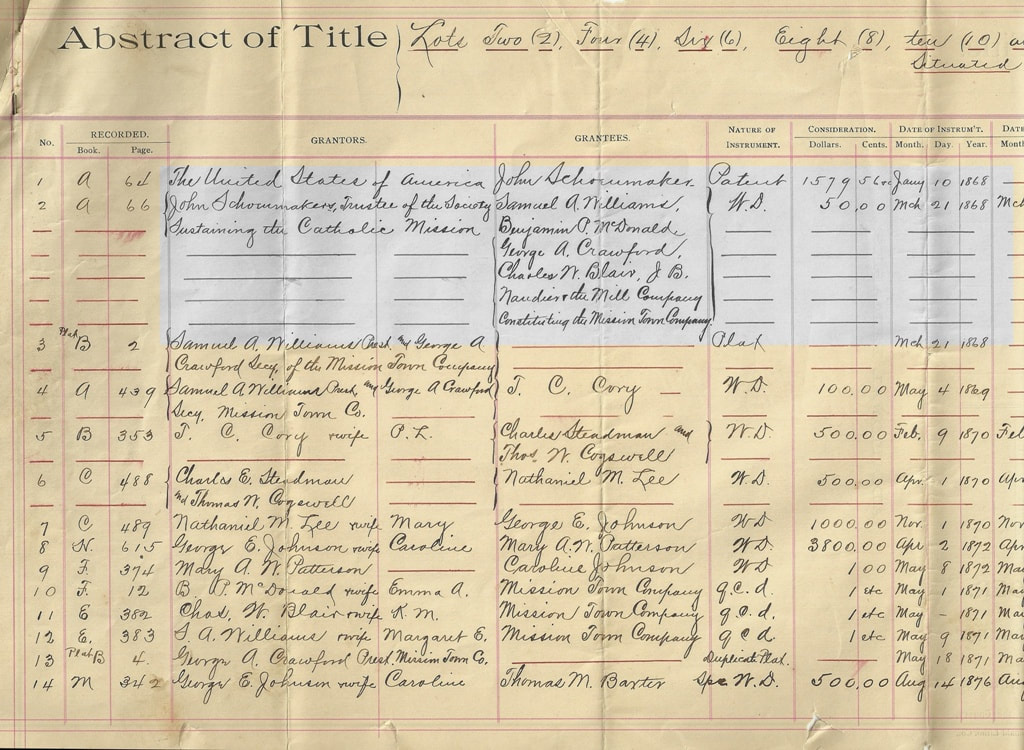 The highlighted portion of the Abstract of Title book shows two separate transactions: First, the receipt of Osage Lands by Father John Schoenmakers under terms of the Treaty of 1865. That transfer occurred, via a land patent between the U.S. Government and Father Schoenmakers on January 10, 1868. The second transaction was a warranty deed, transferring part of the land to the Osage Mission Town Company on March 21, 1868. During the next year, the town was laid out with lots and streets. Plans were made to dedicate a portion of the property sales to a very unique school system. On April 10, 1869, the first meeting of the trustees of the Osage Mission Town Company was held. When Father Schoenmakers was satisfied that his mission town was in good hands, he backed away to devote his energy to the new schools and a church. [2] It is also noted that eighteen days after the first trustees meeting, they met again for their first "Special Meeting". They approved two saloon licenses. The first "Irrigating Fountain" in the new town of Osage Mission was established by Joseph Roycroft as "Master of Ceremonies." Our Irish and German ancestors had some priorities. Another date we need to remember is April 28, 2022. We are also going to have to practice saying "Dodransbicentennial" — 175 Years! Some Reference Information:
1. Saint Paul celebrated their sesquicentennial in 1997 — commemorating 150 years from the date the Jesuits arrived at the Catholic Mission and opened the boy's department of the Osage Manual labor school. 2. It is also likely that Father Schoenmakers withdrew from the town company to avoid involvement with any business issues or improprieties that might have occurred during startup of the town. 3. For more information about the founding of the town of Osage Mission follow THIS LINK. For more information about the treaty negotiations that resulted in Father Schoenmakers receiving land from the Osages, follow THIS LINK. 4. Illustration. The source of the Abstract of Title page, above, is the Neosho County, Register of Deeds office, Erie, Kansas. Photo editing was done by the writer. In 1934 William Whites Graves published his original Annals of Osage Mission with the idea of furnishing available, compact data for writers; and for the general information of the public. When the Graves Memorial Library prepared the book for reprinting, in 1987, they substantially improved it as a research too. John H. Scott published the first issue of The Osage Mission Journal on August 5, 1868. That issue started one of the longer-running Kansas frontier newspapers. In fact, his Journal continued sixty-six years past the the town of Osage Mission's name change to St. Paul. [1] When W. W. Graves published the Annals of Osage Mission his intent was to compile excerpts from the Journal's frontier period stories up to July 4, 1895 — the date of the town's name change. in 1987 the Graves Memorial Public Library staff decided to reprint Graves' Annals. Before they printed, they compiled a very detailed index. In doing so, Helen Schoenhofer Coomes and Wendell Shaw transformed Graves' original work into an even more valuable research tool. The structure of the book is simple:
Not Just For Locals. The town of Osage Mission was within the first block of land ceded by the Osage Tribe under the Canville Treaty (1865).[2] The rest of the Osage reserve was released for settlement in 1870. We got about a five-year head start with settlement, compared to the western counties. As a result, quite a few families stopped at Osage Mission, participated in the initial building boom, lived here for awhile, and then moved on. When I look through the index there are many familiar names. But there are many more names, and stories, that are unfamiliar. The offspring of these families are scattered by now, but might be curious about their origins. During the period of 2009 through 2014 alone, I am aware of researchers who came to St. Paul from California, Canada, New York and several other locations to do family or general historical research. Museum research staff have also responded to emails from across the United States, Ireland, Netherlands, France and other locations. These are from people who have ties to the Osage Catholic Mission and the town of Osage Mission - St. Paul. Bottom Line — if your family passed through Osage Mission, or the Neosho County area, during the mid to late 1800's, they might well have left tracks in this book. The same might be true of frontier era lodges, businesses or organizations such as the Anti-Horse Thief Association. Description and Sources. The 1987 printing of the book is in 5-3/8" x 7-3/8" format, hard-bound with blue cover and gold backbone lettering. Contents are discussed above; 622 pages including the index. New copies of the book are available from The Osage Mission, Neosho County Historical Society or The Graves Memorial Public Library, both in St. Paul. At last check, the price was still $16 at both locations. [3] Mail orders are best processed through the historical society who will add a $4 book mailing fee: Osage Mission - Neosho County Historical Society 203 Washington St, St Paul, KS 66771 Phone: (620) 449-2320 (un-attended during closed hours)* Email: [email protected] (best contact method) * See website for current hours: www.osagemission.org. The Graves Memorial Public Library Phone Number is: (620) 449-2001 This gallery will give you an idea of format and index content. Some Reference Information.
1. The "Journal" had three names during its ninety-three year life (1868 - 1961). John Scott started it as the Osage Mission Journal. It was also published as the Neosho County Journal and St. Paul Journal. There were several editors and owners, and at least one shift in politics, but the same business lineage was retained during its lifespan. W. W. Graves was the longest-term editor/owner. 2. The Osage Reserve was a fifty mile wide strip (north-south) that extended from just east of the Neosho-Labette County lines, west to near Dodge City. When the Canville treaty was ratified in 1865, the Osage ceded land roughly equivalent to Neosho and Labette Counties, plus a strip across the northern edge of their reserve. Osage Mission was in the east part of the Canville land cession and was also close to the Missouri Line. Quite a few settlers stopped first at new settlements, such as Osage Mission, then move on later to pursue other opportunities. For more information about the departure of the Osage and land cession treaties follow THIS LINK. 3. I have seen this book offered from on-line booksellers including Amazon and Abe Books in the $80 - $90 range, used. A couple of years ago a copy showed up from a Missouri Abe Books seller for $275. 4. We have no personal financial interest in the sales of this book. Osage historian and author Louis Burns credited the Osage Mission missionaries with being the main line of defense between his people and extinction: "The Jesuits and Sisters of Osage Mission, probably more than any other outside factor, were responsible for the survival of the Osage people. It is no small wonder that eighty percent of the Osages are still Catholic today. These dedicated souls accomplished more than they lived to realize. Their Influence on the souls and aspirations of the Osage people is still present today.” Louis Burns — A History of the Osage People, 1989 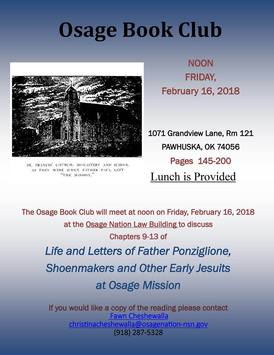 Click to enlarge. Click to enlarge. The missionaries educated the Osage children; they supported their spiritual needs; they treated their illness during the horrible epidemics of the 1850's and Father John Bax died with them. Father Schoenmakers served as their business, and legal as well as spiritual adviser. The advertisement at right has been posted to the Osage Nation and Osage Cultural Center pages several times recently. The picture is of St. Francis Church, Monastery and Academy in the middle 1880's. It should not be a surprise that Friday's Osage Book Club meeting discussed pages from W. W. Graves' "Life and Letters of Father Ponziglione, Schoenmakers, and Other Early Jesuits of Osage Mission." Their time in Kansas was not pleasant. But the Osages still know that our Jesuit and Loretto Missionaries helped them get through it. They haven't forgotten us. For more information about the tragedies and triumphs of the Osages time here, follow THIS LINK.
Stuff that catches your eye around the edges of a microfilm viewer screen .... There was a breed of early newspaper editors who believed that squeaky wheels attracted subscriptions. News stories need to be "beefed up." Confrontational editorials were targeted at local businesses, politicians, labor leaders, private citizens or even competing editors. A healthy dose of vitriolic rhetoric might sell papers; and consequences occasionally spilled out into the street as loud yelling-matches and an occasional fist-fight. Uhhhhh ... Maybe not so serious. The April 15 issue of the Journal doesn't say what the authorities thought about this "Ghastly" little squabble. I suspect they weren't amused. I don't know much about the "tabernacle meetings" in Girard, other than that they were fairly frequent at the time. Also, the Girard Independent News appears to have closed in 1909. I was looking though St. Paul Journal articles, about another subject, and got a giggle from this.
I came across this while looking though microfilm. It is from the February 12, 1873 issue of the Neosho County Journal [1]. The directions — about eight miles east of this city (Osage Mission) — seem odd until you realize there were no real roads at that time. 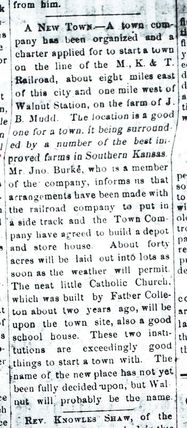 Click to Enlarge. Click to Enlarge. "A NEW TOWN — A town company has been organized and a charter applied for to start a town on the line of the M, K & T Railroad, about eight miles east of this city and one mile west of Walnut Station, on the farm of J. M. Mudd. The location is a good one for a town, it being surrounded by a number of the best improved farms in Southern Kansas. Mr. Jno (?) Burke, who is a member of the company, informs us that arrangements have been made with the railroad company to put in a side track and the Town Company have agreed to build a depot and store house. About forty acres will be laid out into lots as soon as the weather will permit. The neat little Catholic Church, which was built by Father Colleton about two years ago, will be upon the town site, also a good school house. These two institutions are exceedingly good things to start a town with. The name of the new place has not yet been fully decided upon, but Walnut will probably be the name." The timing seems right because it is recorded that Osage Mission Jesuit missionary Philip Colleton started a mission station at Walnut (Station) in Crawford County during 1869. The station was initially started at Mr. Clements home for railroad workers and white settlers. He later built a Church of St. Ann's. 1. The Neosho County Journal is one of three names held by a long-running pioneer newspaper. The paper started in 1868 as the Osage Mission Journal. Later the name was changed to the Neosho County Journal for broader appeal. It ended its ninety-three year run in 1961 as the St. Paul Journal. Not bad in an era when newspaper life-spans were often decided by local elections.
|
Thoughts 'n ThingsSome 'Thoughts' and short articles about past and present-day St. Paul and the Southern Kansas - 4 State Region. Archives
December 2023
Categories
All
|
- Home
-
Our Story
- 1. The Stage is Set
- 2. The Osages Enter Kansas.
- 3. Earliest Commerce
- 4. Earliest Protestant Missions
- 5. The Catholic Osage Mission >
- 6. Progress and Tragedy
- 7. The Missionary Trails >
- 8. A Dangerous Balance - The Civil War >
- 9. The Osage Leave Kansas >
- 10. A Very Unique Community is Born >
- 11. Regional Boarding Schools >
- 12. Transitions
- 13. The Passionists Era Begins
- 14. Citizen Lawmen - The A.H.T.A. >
- 15. The Passionist Influence is Expanded
- 16. The Schools Today >
-
Characters
- The Osages
-
The Missionaries
>
- Father John Schoenmakers >
- Fr. John Bax >
- Mother Bridget Hayden
-
Fr. Paul Ponziglione
>
-
Father Paul's Memoir
>
-
Index - Father Paul's Memoir
>
- Dedication & Introduction
- IX. Construction & Acceptance of Mission Buildings.
- X. Fr. Schoenmakers Arrives at Osage Mission
- XI. Miss Lucille St. Pierre Came to the Neosho
- XII. Progress of the Schools
- XIII. Origin and Development of the Roman Catholic Church in Kansas
- XXVII - Winds of War
- XXVIII — Fr. Schoenmakers Return
- Chapter XLII - Farming Issues, Death Of Father Colleton
- Chapter XLIX - Includes The Death of Fr. Schoenmakers
- Chapter L — Dedication of the New Church
- Conclusion
- Appendix I — Copy of a letter to Sister M. Coaina Mongrain about the coming of the Sisters of Loretto at Osage Mission
- Appendix 6 — A Sketch of my Biography
- Appendix 7 - Letter to W. W. Graves
-
Index - Father Paul's Memoir
>
-
Father Paul's Memoir
>
- Father Philip Colleton
- Brother John Sheehan
- W. W. Graves
- 17 Sisters
- 17 Sisters II - Fr. Fox's Sermon
-
Who's Behind the Window
>
- Who We Were 120 Years Ago
- 1. The Thomas Carroll Window
- 2. The W.W. O'Bryan Window
- 3. The Jas. Owens & Family Window
- 4. The C.P & C.J. Hentzen Windows
- 5. The Dr. McNamara & Family Window
- 6. The Fitzsimmons & Family Window
- 7. The Parents of T.K. Joyce Window
- 8. J.E. Sevart & Family Window
- 9. The Rev. John Schoenmakers S.J. Window
- 10. The Patrick Diskin and L&M George Window
- 11. The J.A. Johnston & Family Window
- 12. The Peter & Jacob Bonifas Windows
- 13. The Mr & Mrs. Patrick Keeting Window
- 14. The John Butler Window
- 15. The Mr. & Mrs. Gutting Window
- 16. Rosette Window Above Doors
- 17. The Michael A. Barnes Window
- 18. The Henry M. O'Bryan Window
- 19. The John and Bridget McCarthy Window
- The Sodality Windows
- The Church Women's Bonfire (Graves)
- Beechwood
- John and Margaret Naudier
- Fr. Tom McKernan - The Poet Priest of Kansas
- The Dimond Family and Estate Sale
- Dear Sister >
- A Year and a Day — Passionist Memories.
- Mary Elizabeth Lease
- K of C Council 760 - The Early Days
- Our Hometown Boys
- SPHS Class of 1956
-
Places
- The Great American Desert
- St. Francis Catholic Church
- St. Francis de Heironymo Catholic Church Grounds
- St. Paul - 135 Years Ago
- St. Paul - 1890's as a Scale Model.
- St. Paul - The Booming 60's
- Osage Mission as a Statewide History Finalist
- St. Francis Cemetery
- Hope Cemetery
- The Basement Chapel
- World War I Museum Display
- St. Paul Middle School >
- Ladore
- St. Boniface, Scipio KS
- Road Trip - Father Emil Kapaun
- Exchange State Bank Robbery!
- Thoughts ...
- Links
- Link Page
Thoughts 'n Things
Past and Present Day St. Paul, Southern Kansas and The Four - State Region.

|
acatholicmission.org is a privately hosted website. We hope that our site will educate and entertain those who are interested in the fascinating Osage Mission - St. Paul - Neosho County Kansas story. Ours is a regional story that crosses state lines, ethnic groups, faiths and a variety of frontier and post-frontier interests. Enjoy.
acatholicmission.org Copyright © 2016 - 2024. All rights reserved. (See copyright note on Contact page.) |
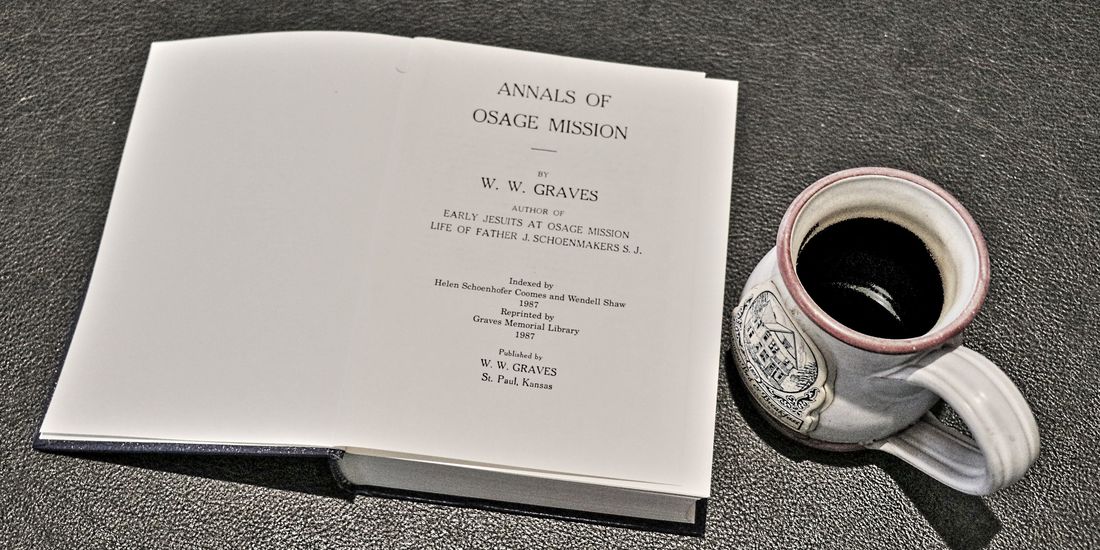

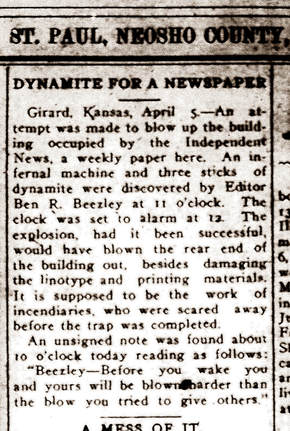
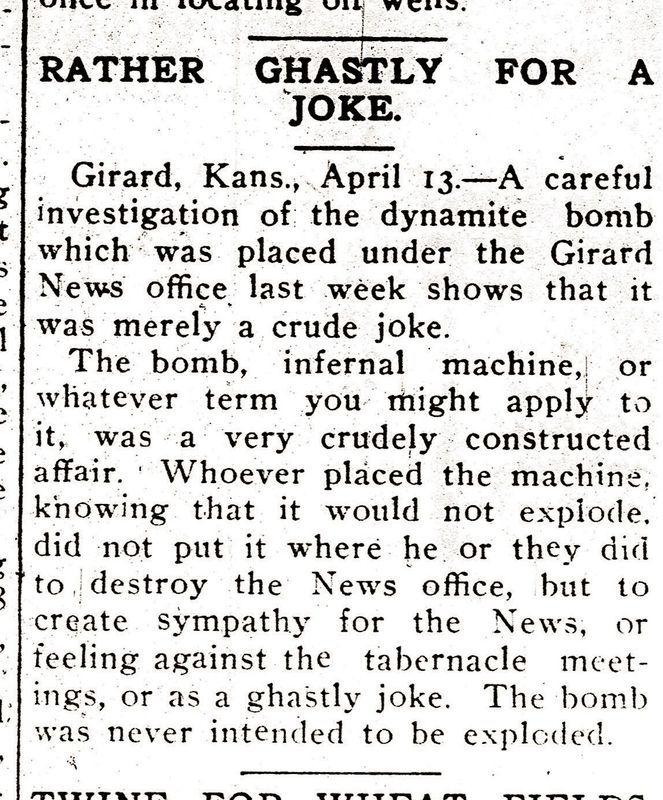
 RSS Feed
RSS Feed